Galls or cecidia are a kind of swelling growth on the external tissues of plants. Plant galls are abnormal outgrowths of plant tissues, similar to benign tumors or warts in animals. They can be caused by various parasites, from viruses, fungi and bacteria, to other plants, insects and mites. Plant galls are often highly organized structures so that the cause of the gall can often be determined without the actual agent being identified. This applies particularly to insect and mite plant galls. The study of plant galls is known as cecidology.
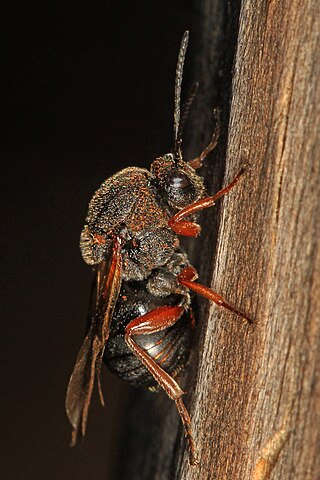
Gall wasps, also traditionally calledgallflies, are hymenopterans of the family Cynipidae in the wasp superfamily Cynipoidea. Their common name comes from the galls they induce on plants for larval development. About 1,300 species of this generally very small creature are known worldwide, with about 360 species of 36 different genera in Europe and some 800 species in North America.
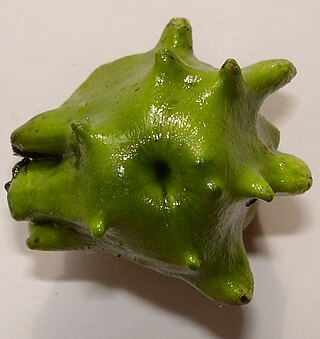
Andricus quercuscalicis is a gall wasp species inducing knopper galls.

Andricus kollari, also known as the marble gall wasp, is a parthenogenetic species of wasp which causes the formation of marble galls on oak trees. Synonyms for the species include Cynips kollari, Andricus quercusgemmae, A. minor, A. indigenus and A. circulans.

Andricus foecundatrix is a parthenogenetic gall wasp which lays a single egg within a leaf bud, using its ovipositor, to produce a gall known as an oak artichoke gall, oak hop gall, larch-cone gall or hop strobile The gall develops as a chemically induced distortion of leaf axillary or terminal buds on pedunculate oak or sessile oak trees. The larva lives inside a smaller hard casing inside the artichoke and this is released in autumn. The asexual wasp emerges in spring and lays her eggs in the oak catkins. These develop into small oval galls which produce the sexual generation of wasps. A yew artichoke gall caused by the fly Taxomyia taxi also exists, but is unrelated to the oak-borne species. Previous names or synonyms for the species A. fecundator are A. fecundatrix, A. pilosus, A. foecundatrix, A. gemmarum, A. gemmae, A. gemmaequercus, A. gemmaecinaraeformis and A. quercusgemmae.
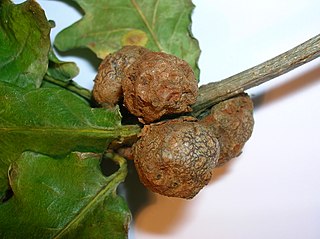
Cola-nut galls develop as a chemically induced distortion of leaf axillary or terminal buds on pedunculate oak or sessile oak trees, caused by the agamic gall wasp Andricus lignicola which lays single eggs within leaf buds using their ovipositor. A previous name or synonym for the species A. lignicola is A. lignicolus and A. venheurni.

Andricus is a genus of oak gall wasps in the family Cynipidae.

Andricus grossulariae is a gall wasp species inducing agamic acorn cup galls on oak tree acorn cups and sexual phase galls on catkins. Synonyms include Andricus fructuum, Andricus gemellus, Andricus intermedius, Andricus mayri and Cynips panteli.

Pammene amygdalana is a species of moth of the family Tortricidae. It is found from Belgium and Germany to the Iberian Peninsula, Italy, Austria and Hungary and from France to Romania and Bulgaria.

Andricus quercuscalifornicus, or the California gall wasp, is a small wasp species that induces oak apple galls on white oaks, primarily the valley oak but also other species such as Quercus berberidifolia. The California gall wasp is considered an ecosystem engineer, capable of manipulating the growth of galls for their own development. It is found from Washington, Oregon, and California to northern regions of Mexico. Often multiple wasps in different life stages occupy the same gall. The induced galls help establish complex insect communities, promoting the diversification in niche differentiation. Furthermore, the adaptive value of these galls could be attributed their ecological benefits such as nutrition, provision of microenvironment, and enemy avoidance.

Andricus aries is a species of gall-forming wasps, in the genus Andricus. The species was named by the French entomologist Joseph-Étienne Giraud, in 1859. It is commonly found in eastern Europe and during the 21st century has spread to western Europe.

Feron kingi, the red cone gall wasp, is a species of gall wasp in the family Cynipidae.

Andricus corruptrix is a species of gall-forming wasp, in the genus Andricus. It is found in Europe.

Andricus inflator is a species of gall-forming wasps, in the genus Andricus, which has a sexual and an asexual generation, producing two different galls. The wasp was named by the German biologist Theodor Hartig, in 1840 and is found in Europe.
Andricus infectorius is a species of gall-forming wasp. The species was named by the German biologist Theodor Hartig, in 1843 and is found in Europe.
Andricus mukaigawae is a species of gall wasp native to southeastern Asia. It creates galls on the buds and leaves of oak trees. The galls are sometimes used by other gall wasps unable to create galls of their own, with both species sharing the gall.
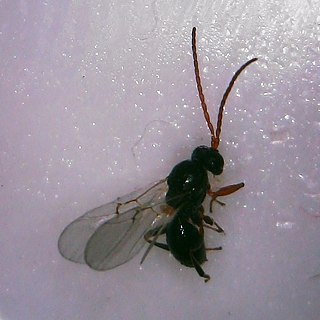
Andricus quercuspetiolicola, also called the oak petiole gall wasp, is a species of oak gall wasp in the family Cynipidae. Galls in which the larvae live and feed are formed along the midrib or petiole of white oak leaves.
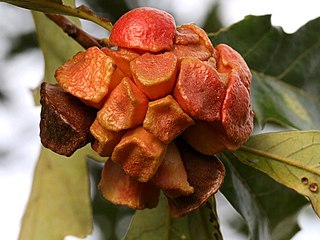
Andricus quercusstrobilanus, the lobed oak gall wasp, is a species of gall wasp in the family Cynipidae, found in North America. The quercus in its specific name is the genus name for oak, while "strobilus" is derived from the Greek strobilo which means "cone", a reference to the cone shape of the gall; thus the gall is sometimes called pine cone oak gall.
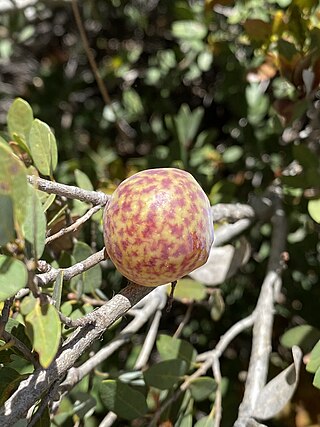
Trichoteras vacciniifoliae, formerly Andricus vacciniifoliae, the golden oak apple wasp, is a species of gall-forming hymenopteran. The wasp creates a stem gall on host plants, namely huckleberry oaks and canyon live oaks. Andricus vacciniifoliae is native to the west coast of North America. Because of their colorful appearance and location on the plant, the galls are often mistaken for fruit. The larval chamber is at the center of the gall, connected to the husk by slender, radiating fibers.

Trichoteras is a genus of gall-inducing Hymenopteran that has several species formerly classed as Andricus. Trichoteras characteristics include antennae with 10 flagellomeres. An entomologist writing in 2018 stated that "is questionable that Heteroecus and Trichoteras should be synonymized with Andricus" in regard to a proposed taxonomic reorganization of 2002. Ronald A. Russo in Plant Galls of the Western United States moves species like the golden oak apple wasp from Andricus to Trichoteras, while acknowledging the previously accepted binomials. William Harris Ashmead first defined this genus in 1897.
















